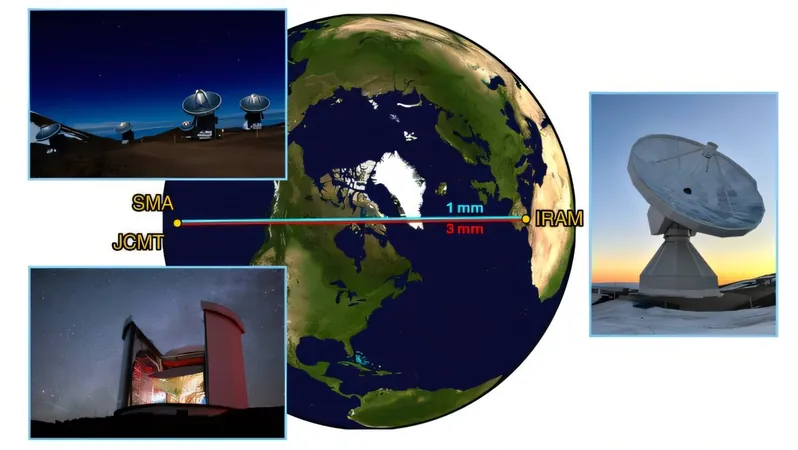
Astronomers Pave the Way for Multi-Color Black Hole Observations with Groundbreaking Technique
2025-05-21
Author: Nur
A Game-Changer for Black Hole Research
In a stunning breakthrough, an international team of astronomers has unveiled a revolutionary technique that enhances the observation of faint black holes by correcting atmospheric distortions on Earth. This innovative method, known as "frequency phase transfer (FPT)," significantly boosts the sensitivity of the Event Horizon Telescope (EHT) network, positioning it for unprecedented discoveries.
Connecting the Dots: A Collaborative Effort
By synchronizing observations from three pivotal EHT telescopes—the IRAM 30-meter telescope in Spain, the James Clerk Maxwell Telescope, and the Submillimeter Array in Hawaii—astronomers demonstrated that atmospheric measurements at a wavelength of 3mm could effectively improve data collected at a finer wavelength of 1mm. This collaboration marks a significant step forward in the quest to unlock the mysteries of black holes.
The Power of the EHT
The EHT is a groundbreaking array of global radio telescopes employing a technique known as very long baseline interferometry (VLBI) to capture the sharpest images in astronomy. By digitally combining signals from these telescopes, the EHT creates a virtual telescope as vast as the Earth itself, which infamously produced the first-ever image of a black hole.
Facing Atmospheric Hurdles
Operating an Earth-sized telescope poses unique challenges, particularly the need to penetrate Earth's turbulent atmosphere. This turbulence can distort radio signals, preventing longer exposure times and limiting observations to only the brightest cosmic objects. The FPT technique, initially developed for VLBI, has now proven effective in overcoming some of these atmospheric barriers.
Unlocking the Faintest Black Holes
FPT operates by utilizing data taken at one wavelength to gauge how much the atmosphere scrambles signals, and then applying that analysis to refine data captured at another wavelength. With this capability, the EHT can extend observation times and potentially glimpse much fainter black holes, opening new avenues for astrophysical research.
Future Prospects and Challenges
While the FPT technique holds immense promise, it does come with implementation challenges. For a telescope to effectively use FPT, it needs to observe at multiple wavelengths simultaneously—a capability not widely available among current EHT telescopes. This limitation reinforces the urgency of developing additional multi-color capabilities within the EHT, a priority in ongoing projects like the next-generation EHT (ngEHT) and the Black Hole Explorer (BHEX).
The Dawn of a New Era in Black Hole Observation
With the successful application of FPT, the EHT is making strides toward an exciting future where even the faintest black holes can be studied in vivid detail. This breakthrough not only enhances our understanding of black holes but invites a whole new world of astronomical exploration.

 Brasil (PT)
Brasil (PT)
 Canada (EN)
Canada (EN)
 Chile (ES)
Chile (ES)
 Česko (CS)
Česko (CS)
 대한민국 (KO)
대한민국 (KO)
 España (ES)
España (ES)
 France (FR)
France (FR)
 Hong Kong (EN)
Hong Kong (EN)
 Italia (IT)
Italia (IT)
 日本 (JA)
日本 (JA)
 Magyarország (HU)
Magyarország (HU)
 Norge (NO)
Norge (NO)
 Polska (PL)
Polska (PL)
 Schweiz (DE)
Schweiz (DE)
 Singapore (EN)
Singapore (EN)
 Sverige (SV)
Sverige (SV)
 Suomi (FI)
Suomi (FI)
 Türkiye (TR)
Türkiye (TR)
 الإمارات العربية المتحدة (AR)
الإمارات العربية المتحدة (AR)